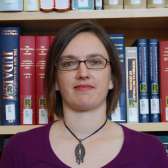
"Jewish Space in Germany after the Holocaust: The Möhlstrasse of Munich"
Professional Background
Anna Holian is Assistant Professor of Modern European History at Arizona State University in Tempe. She received her Ph.D., M.A., and B.A. in history from the University of Chicago. For her Sosland Foundation Fellowship, she conducted research on “Jewish Space in Germany after the Holocaust: The Möhlstrasse of Munich.”
Dr. Holian is the author of Between National Socialism and Soviet Communism: Displaced Persons in Postwar Germany (University of Michigan Press, forthcoming) as well as several pieces on refugees and postwar reconstruction in Europe, including, “Displacement and the Post-War Reconstruction of Education: Displaced Persons at the UNRRA University of Munich, 1945–1948,” in Contemporary European History 17:2 (May 2008); “Anticommunism in the Streets: Refugee Politics in Cold War Germany,” in the Journal of Contemporary History (forthcoming); and “Between Nationalism and Internationalism: Displaced Persons at the UNRRA University of Munich,” in Diaspora Identities: Exile, Nationalism and Cosmopolitanism in Past and Present, ed. Susanne Lachenicht and Kerstin Heinsohn (University of Chicago Press/Campus Verlag, forthcoming). She has received fellowships and awards from the German Academic Exchange Service (DAAD), the Goethe Institute, the National Science Foundation, the University of Chicago, and Arizona State University. She participated in the Center for Advanced Holocaust Studies, United States Holocaust Memorial Museum’s 2007 Summer Research Workshop on Geography and the Holocaust and the 2006 Reading Yiddish for Holocaust Research program, co-organized by Indiana University and the United States Holocaust Memorial Museum. Dr. Holian has language skills in German, Ukrainian, French, Yiddish, Russian, and Polish.
Fellowship Research
During her tenure at the Center, Dr. Holian researched Jewish space in Germany after the Holocaust, focusing specifically on the Möhlstrasse in Munich. Beginning from the premise that how people use space is an important index of how they see the world and their place in it, she examined how Jewish displaced persons (DPs) created autonomous social spaces in Germany and how they shared space with other groups in German society. She focused especially on how Jewish survivors appropriated “German” space for their own political and economic activities. The area around the Möhlstrasse, a four-block long street in the upper-middle class neighborhood of Bogenhausen, was home to many Jewish organizations, a place of extensive interaction between Jews and non-Jews, and a thriving commercial and black market center. Dr. Holian’s project brought together two areas of research in Jewish history—Jewish DPs and Jewish space—to shed new light on the reconstruction of Jewish life in postwar Germany. Dr. Holian used the Museum’s extensive archival collections, including the YIVO displaced persons camps collection, private collections relating to displaced persons, and the DP periodicals collection, as well as collections at the U.S. National Archives and Records Administration on Möhlstrasse from the perspective of U.S. and German authorities.
Dr. Holian was in residence at the Mandel Center from September 1 to December 30, 2009.
